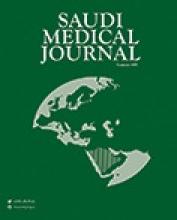Abstract
OBJECTIVES: To determine the risk factors predisposing to fetal macrosomia and assess the maternal and perinatal outcome in these patients.
METHODS: This was a retrospective analysis of all macrosomic deliveries in the Department of Obstetrics and Gynecology, Sultan Qaboos University Hospital, Sultanate of Oman, during a 3-year period from January 2001 -- December 2003. The maternal and neonatal records of infants with birth weight of > or =4000 g (n=275) were reviewed. Outcome variables included demographic profile, antenatal risk factors, mode of delivery and maternal and perinatal complications.
RESULTS: A total of 7367 deliveries occurred during the study period. The rate of macrosomic deliveries was 3.75% and the rate of deliveries > or =4500 g was 0.48%. The mean birth weight of the study group was 4230 ± 220 g. Obesity, diabetes, prolonged gestation and postpartum hemorrhage were significantly higher in the study group. The cesarean section rate was 25.8% for the study group compared to the general incidence of 13.1% during the study period (p<0.0001). The incidence of shoulder dystocia was 7.6% compared to the general incidence of 0.48% during the study period (p<0.0001). There were 7 cases of Erb's palsy, all except one recovered without sequelae by 3 months of age.
CONCLUSIONS: Gestational diabetes, maternal obesity, increasing age and parity were the main risk factors for fetal macrosomia. The incidence of shoulder dystocia, birth injuries and neonatal morbidity increased in this group.
- Copyright: © Saudi Medical Journal
This is an open-access article distributed under the terms of the Creative Commons Attribution-Noncommercial-Share Alike 3.0 Unported, which permits unrestricted use, distribution, and reproduction in any medium, provided the original work is properly cited.






